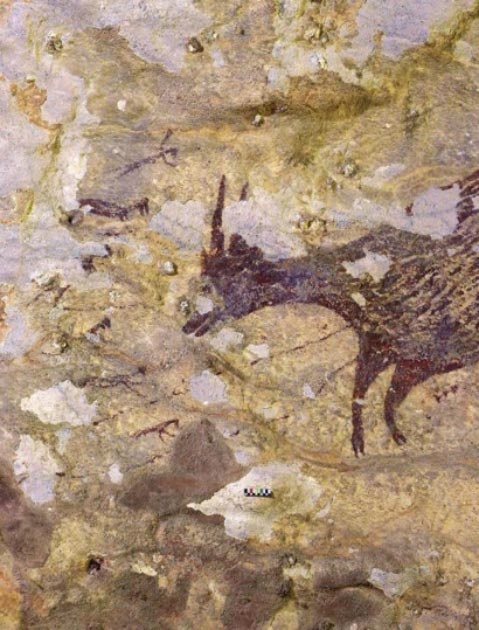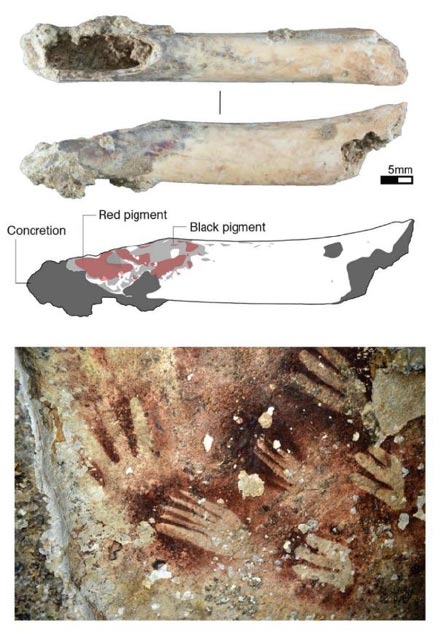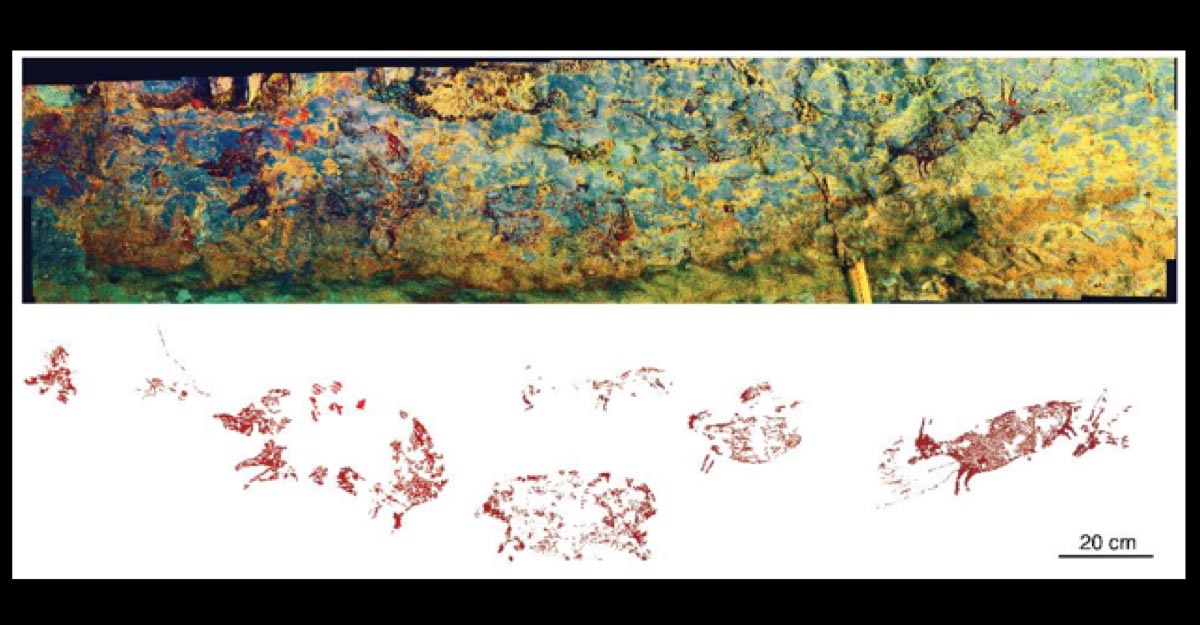Indonesian Cave Art Demands Human Cultural Evolution Overhaul
A major discovery has been made in a limestone cave in Sulawesi, Indonesia - the earliest known hunting scene in the world has been identified on a hard to reach cliff face. At least 43,900 years ago someone decided to climb up into the cave and depict a group of human-like figures hunting pigs and buffaloes. Unlocking the meaning behind the artist’s symbolic system is near-impossible without access to a time machine, but there is much that can still be learned from the Indonesian cave art.
The panel of art was discovered in the Leang Bulu’ Sipong 4 cave and the researchers wrote in the journal Nature that “This hunting scene is—to our knowledge—currently the oldest pictorial record of storytelling and the earliest figurative artwork in the world.” That means it’s a pretty big discovery for people interested in human cultural evolution.

Sulawesi hunting scene. (Credit: Ratno Sardi)
Human-Like Figures on a Hunt
What they found is a 4.5-meter-wide (14.76 ft.) panel of cave paintings depicting eight small human-like figures armed with spears or ropes accompanied by two Sulawesi warty pigs and four dwarf buffaloes known as anoas, which the researchers have described as “small but fierce bovids that still inhabit the island’s dwindling forests.” It appears to be a hunting narrative. All of the beings seem to have been painted with the same artistic style and technique and dark red pigment.
- Ten Amazing Caves of the Ancient World
- Archaeologists Identify First Prehistoric Figurative Cave Art in Balkans - It’s Symbolic!
- Did Humans Speak Through Cave Art? Ancient Drawings and Language's Origins
When Ancient Origins contacted Adam Brumm, study co-author and associate professor from the Australian Research Centre for Human Evolution (ARCHE), to find out more about the discovery and what it may have meant to the prehistoric artist or artists who created it, he stated that there are indications that the cave art “could reflect the handiwork of a single artist, but we can’t intuitively rule out the involvement of other individuals at this stage.”
The anthropomorphic figures are referred to as therianthropes because they have some animalistic features such as long lower faces which resemble snouts or muzzles. One of the researchers, PhD student Adhi Agus Oktaviana, explained their appearance in more detail in a Griffith University press release, stating, “The hunters represented in the ancient rock art panel at Leang Bulu’ Sipong 4 are simple figures with human-like bodies, but they have been depicted with heads or other body parts like those from birds, reptiles, and other faunal species endemic to Sulawesi.”
Cave Art for Ritual or Spiritual Purposes?
When asked about the significance of the location of the painting, Brumm said:
“The cave itself shows no other signs of human habitation apart from the paintings. This observation, and the fact that it is located in a difficult-to-reach spot in a cliff face several metres above the ground. This could possibly suggest the cave site itself (and/or the act of creating art in what would appear to be a liminal location) had some sort of special cultural/ritualistic significance and meaning.”

The cave art panel. (Credit: Kim Newman)
This idea is further promoted by the depiction of therianthropes, which the study authors suggest in the press release “may also be the oldest evidence for our ability to imagine the existence of supernatural beings, a cornerstone of religious experience.” Or, the archaeologists suggest the images show the artist was probably pondering the human-animal connection, possibly in a spiritual frame of mind.
In the press release, Brumm explored this notion even further, “The images of therianthropes at Leang Bulu’ Sipong 4 may also represent the earliest evidence for our capacity to conceive of things that do not exist in the natural world, a basic concept that underpins modern religion,” he said and continued:
“Therianthropes occur in the folklore or narrative fiction of almost every modern society and they are perceived as gods, spirits, or ancestral beings in many religions worldwide. Sulawesi is now home to the oldest image of this kind – earlier even than the ‘Lion-man’ from Germany, a figurine of a lion-headed human, which, at 40,000 years old, was until now the oldest depiction of a therianthrope.”

Therianthrope figure of a human with a tail. (Credit: Ratno Sardi)
In the Nature article the authors reject the suggestion that the human-like figures were meant to depict camouflaged hunters because “this would have the improbable implication that hunters were disguising themselves as small animals such as birds.” Instead they write:
“The conspicuousness of therianthropes in the oldest recorded hunting scenes also offers hints at the deeply rooted symbolism of the human–animal bond and predator–prey relationships in the spiritual beliefs, narrative traditions and image-making practices of our species.”
Cave Popcorn for Painting Dates
Brumm informed Ancient Origins that while the cave art’s location itself wasn’t appropriate for archaeological excavations, “There is not anywhere to excavate inside the cave art site Leang Bulu’ Sipong 4 as an archaeological deposit did not form within it,” he said “But we have excavated some other cave art sites in the nearby region. Unlike Leang Bulu’ Sipong 4, these sites are located at ground level and our excavations have revealed abundant archaeological evidence dating back to the time of the earliest rock art.”

Hollow bone tube (top) with red and black pigments, made from the long bone of a bear cuscus, may have been used as an ‘air-brush’ to create human hand stencils on rock surfaces (bottom). ((Top) Michelle Langley (bottom) Yinika Perston)
That means that there were no artifacts to use to help date the cave art which was discovered in 2017 but is appearing now in the Nature article. However, they had another method – and it involved something the researchers refer to as ‘cave popcorn.’
The Griffith University press release states that the researchers used Uranium-series analysis to date the ‘mineral growths (‘cave popcorn’) that had formed on the cave painting’ and obtained results ranging from 35,100 to 43,900 years ago. As a comparison, the dates for Upper Paleolithic cave art in Europe are generally given as between 21,000–14,000 years ago.
Professor Aubert expressed the importance of thinking about how artistic culture evolved in the press release, “The cave painting from Leang Bulu’ Sipong 4 suggests that there was no gradual evolution of Palaeolithic art from simple to complex around 35,000 years ago –at least not in Southeast Asia. All of the major components of a highly advanced artistic culture were present in Sulawesi by 44,000 years ago, including figurative art, scenes, and therianthropes.”

Therianthrope – human figure with bird features. (Credit: Ratno Sardi)
Local Views and Next Steps
Professor Brumm also worked with fellow Griffith University archaeologist Professor Maxime Aubert, and Sulawesian archaeologist and Griffith University PhD student Basran Burhan. Brumm told Ancient Origins a little about the local perspective on the caves where the paintings are located, he said:
“The local Bugis-Makasar people are generally all devout Muslims but they still have a rich and presumably centuries-old folklore associated with the many limestone caves and rock-shelters in this part of Sulawesi. Most often the caves are viewed as the abode of ghosts or spirits and many people avoid entering them if possible. Local religious specialists (dukun) are often still called in to conduct rituals in the caves to ward-off spiritual dangers before we excavate or do other scientific research in them.”
- Were the Chislehurst Caves Originally Created By Druids?
- Krubera Cave - Journeying to the Depths of Georgia in One of the World’s Deepest Caves
- What Really Went on in the Sculptor’s Cave Where Hundreds of Bronze Age Child Remains Were Unearthed?
Brumm told Ancient Origins that there are plans to continue exploring the area around where the cave art was discovered “this Maros-Pangkep limestone karst region is a very rich rock art province and it is likely there are many more spectacular cave paintings awaiting discovery,” he said.

Maxime Aubert and Adam Brumm with the Indonesian cave art. (Kinez Riza)
As is the case in many areas in the world, the archaeologist also expressed concern that the team is racing against time in their search. In this situation it’s the natural elements and their role in deteriorating the cave art which is the main source of worry. But Brumm expressed the hope “to learn as much as possible about the people who created it, through careful study and dating of the imagery itself and also by excavating the cave art sites to further unlock the mysteries of this ancient artistic culture” by continuing to explore the rich prehistoric art which may still be awaiting discovery in the region.
Top Image: The Indonesian cave art hunting scene panorama. Source: Credit: Adam Brumm, Agus Oktaviana



















